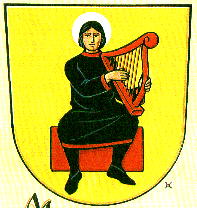Arnoldsweiler: Difference between revisions
Knorrepoes (talk | contribs) No edit summary |
Knorrepoes (talk | contribs) m (Text replace - "[[Literature" to "{{media}} [[Literature") |
||
| Line 22: | Line 22: | ||
As there was no evidence for arms of Arnoldsweiler the municipality decided in 1966 to devise completely new arms. | As there was no evidence for arms of Arnoldsweiler the municipality decided in 1966 to devise completely new arms. | ||
{{media}} | |||
[[Literature]] : Domsta, H.J. : Siegel und Wappen der Stadt Düren und ihrer Stadtteile, Düren, 1985. | [[Literature]] : Domsta, H.J. : Siegel und Wappen der Stadt Düren und ihrer Stadtteile, Düren, 1985. | ||
Revision as of 18:04, 8 July 2014
| Heraldry of the World Civic heraldry of Germany - Deutsche Wappen (Gemeindewappen/Kreiswappen) |
ARNOLDSWEILER
State : Nordrhein-Westfalen
District (Kreis) : Düren
Incorporated into : 1972 Düren
Origin/meaning
The arms were granted in 1966 and show the local saint, St. Arnoldus.
The oldest seal of Anroldsweiler dates from the early 15th century and shows a shield with two lions, with St. Arnoldus as supporter. The shield with the lions is the arms of the Duke of Jülich, who owned the village. The arms are the same as for the Dutch province of Gelderland. The Dukes of Jülich (Gulik) were also Dukes of Gelre. The same composition can be seen on later seals of Arnoldsweiler
In the 16th century Arnoldsweiler was combined with Merzenich and the combined domain used the seal of Merzenich.
As there was no evidence for arms of Arnoldsweiler the municipality decided in 1966 to devise completely new arms.
Contact and Support
Partners:
Your logo here ?
Contact us
© since 1995, Heraldry of the World, Ralf Hartemink 
Index of the site
Literature : Domsta, H.J. : Siegel und Wappen der Stadt Düren und ihrer Stadtteile, Düren, 1985.











